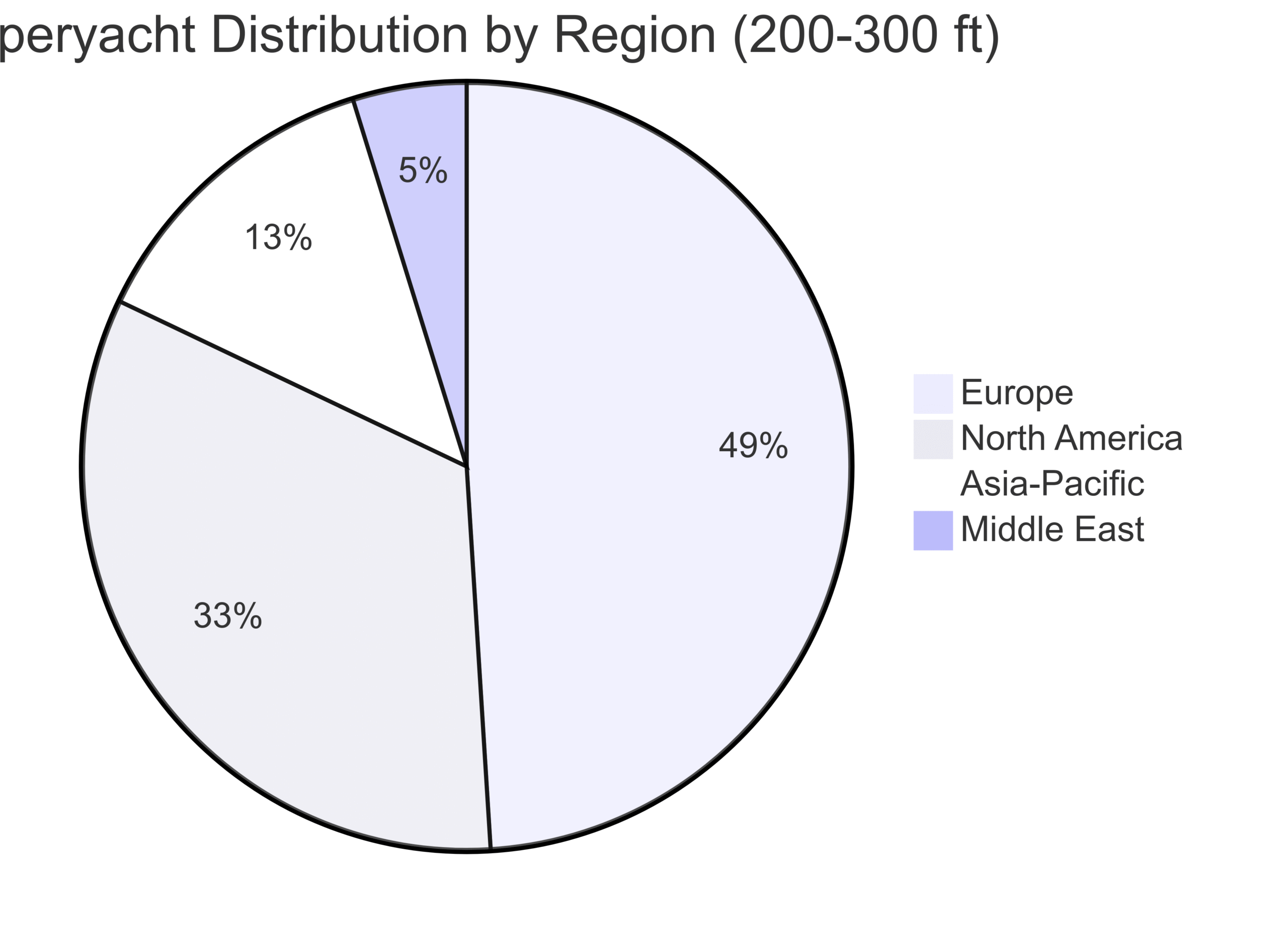How Many Super Yachts Are There In the World?
Discover the world of superyachts: their numbers, top manufacturers, ownership trends, and environmental impact. Explore global distribution and costs.
Superyachts, the epitome of luxury and wealth, glide across the world’s oceans, symbolizing status and extravagance. These vessels, typically over 30 meters (98 feet) in length, are not just boats but floating palaces equipped with opulent amenities and cutting-edge technology. Understanding the scope of the superyacht industry—its numbers, distribution, manufacturers, ownership, and environmental implications—offers a fascinating glimpse into a world reserved for the ultra-wealthy. This article delves into the current state of superyachts, exploring their global presence, the leading builders, ownership patterns, and the challenges they pose to sustainability.
The Global Count of Superyachts
As of recent estimates, there are approximately 5,396 superyachts over 30 meters in operation worldwide, according to the SuperYacht Times’ The State of Yachting 2022 report. This figure reflects a significant increase over the past few decades, with the number of superyachts quadrupling since the 1990s. The industry is thriving, with 1,024 projects under construction or on order as of December 2021, a record high that underscores the growing demand for these luxurious vessels.
Focusing specifically on superyachts in the 200 to 300 feet (60 to 91 meters) range, there are around 1,017 vessels globally. These megayachts, often costing upwards of $20 million, are concentrated in regions with significant wealth and access to prime yachting destinations. The table below provides a breakdown of their distribution and average costs by region:
| Region | Number of Superyachts (200-300 ft) | Average Cost (USD) |
|---|---|---|
| Europe | 123 | $35M – $60M |
| North America | 83 | $40M – $50M |
| Asia-Pacific | 33 | $30M – $50M |
| Middle East | 12 | $100M |
Europe leads with 123 superyachts, with Italy alone accounting for 38, making it the country with the highest number in this size range. The United States follows with 36, trailed by the Netherlands (27), Turkey (22), and the United Kingdom (18). These figures highlight the concentration of wealth and yachting infrastructure in these regions, with the Mediterranean and Caribbean serving as prime cruising grounds.

The global yachting industry is not static. Economic trends, geopolitical events, and shifting wealth patterns influence the number of superyachts. For instance, the post-pandemic era saw a surge in demand as billionaires sought private, socially distanced escapes. However, sanctions on Russian oligarchs following the 2022 Ukraine invasion led to the seizure of several high-profile yachts, slightly reducing the active fleet.
Defining a Superyacht
A superyacht is typically defined as a vessel over 30 meters (98 feet) in length, with those exceeding 60 meters (200 feet) often classified as megayachts, and those over 90 meters (295 feet) as gigayachts. The 200 to 300 feet range, the focus of this article, represents the pinnacle of luxury, offering space for lavish amenities like swimming pools, helipads, cinemas, and expansive staterooms. These vessels are designed for extended voyages, equipped with advanced navigation systems, high-speed internet, and professional crews to cater to every need.
Superyachts are distinguished not only by size but also by their bespoke craftsmanship and opulence. Owners customize every detail, from interior designs featuring rare materials like marble and exotic leathers to engineering tailored to their preferences. For example, the 90-meter DAR by Oceanco features 22 tonnes of seamless black glass, requiring specialized sealants approved by Lloyd’s to maintain structural integrity while enhancing privacy.
The crew is a critical component, often numbering 12 to 50 for a yacht in this size range, ensuring a high level of service. A captain, engineers, chefs, stewards, and deckhands work together to provide an unparalleled experience, from gourmet dining to seamless navigation. The International Convention for the Safety of Life at Sea limits passenger numbers to 12 on most pleasure yachts, but crew numbers are unrestricted, allowing for extensive staff to cater to guests.
Top Manufacturers of Superyachts
The superyacht industry is dominated by a handful of elite shipyards known for their craftsmanship, innovation, and ability to meet the demands of the ultra-wealthy. Below are three leading manufacturers, their notable vessels, and their contributions to the industry.
Lürssen (Germany)
Lürssen, a German shipyard with over 140 years of history, is renowned for building some of the world’s largest and most iconic superyachts. Responsible for 13 of the top 25 largest yachts, Lürssen combines innovative design with seaworthy engineering. Notable vessels include:
- Azzam (180 meters/590 feet, ~$600M): The world’s longest yacht, built for Khalifa bin Zayed Al Nahyan.
- Dilbar (156 meters/512 feet, ~$600M): The largest by displacement, owned by Alisher Usmanov.
- Phoenix 2 (90 meters/295 feet, ~$120M): A luxurious megayacht with spacious interiors.
- Kismet (95 meters/312 feet, ~$200M): Featured in the film Six Underground.
Lürssen yachts average $60M to $120M, with high-end models exceeding $500M. The shipyard is also pioneering sustainability, with a hydrogen fuel cell yacht set for delivery in 2025, capable of emissions-free cruising for over 1,000 nautical miles.
Feadship (Netherlands)
Feadship, a Dutch shipyard since 1949, is synonymous with bespoke craftsmanship and cutting-edge technology. Known for its meticulous attention to detail, Feadship produces yachts that blend performance with luxury. Notable examples include:
- Aquarius (92 meters/302 feet, ~$150M): A sleek, modern megayacht.
- Symphony (101 meters/331 feet, ~$150M): A standout for its innovative design.
- Venus (78.2 meters/256 feet, ~$100M): Built for Steve Jobs with a minimalist aesthetic.
Feadship yachts typically cost $50M to $100M, with premium models exceeding $100M. Their focus on quality materials and contemporary design makes them a favorite among discerning buyers.
Benetti (Italy)
Benetti, one of Italy’s oldest yacht builders since 1873, is celebrated for its elegant designs and Mediterranean flair. The shipyard produces yachts that combine aesthetic appeal with advanced technology. Notable vessels include:
- IJE (108 meters/354 feet, ~$200M): A luxurious gigayacht with expansive amenities.
- Lionheart (90 meters/295 feet, ~$150M): Known for its sweeping lines and opulent interiors.
- Seasense (67 meters/220 feet, ~$60M): A smaller but equally lavish option.
Benetti yachts average $35M to $60M, with top-tier models exceeding $100M. Their Italian craftsmanship appeals to owners seeking a blend of style and performance.

Superyacht Ownership
Superyacht ownership is a hallmark of extreme wealth, with 80% of vessels owned by private individuals and 20% by businesses, corporations, or governments. Private owners, often billionaires, use their yachts for leisure, hosting exclusive parties, or exploring exotic destinations. Corporate owners leverage yachts as floating offices or venues for entertaining clients, benefiting from tax advantages and potential charter income.
The United States leads in ownership, with 23.6% of superyachts over 40 meters, followed by Russia (8.1%), Greece (6.2%), Turkey (5.7%), and the United Kingdom (5.4%). Middle Eastern owners, particularly from the UAE and Saudi Arabia, dominate the top tier, owning nearly one-third of the world’s top 200 superyachts. Notable examples include:
- Dilbar (Alisher Usmanov, Russia): The largest by displacement.
- History Supreme (Robert Knok, Malaysia): The priciest at $4.8B, adorned with gold and platinum.
- Koru (Jeff Bezos, USA): A $500M sailing yacht with a support vessel.
The table below highlights ownership by country:
| Country | Ownership (%) | Average Length (m) |
|---|---|---|
| United States | 23.6% | 54 |
| Russia | 8.1% | 62 |
| Greece | 6.2% | 51 |
| Turkey | 5.7% | 47 |
| United Kingdom | 5.4% | 56 |
Owning a superyacht involves significant costs beyond the purchase price, including annual maintenance (10% of construction cost), crew salaries, and fuel. For example, a 90-meter yacht costing $100M may incur $10M annually in upkeep.
Environmental Impact and Challenges
Superyachts are not just symbols of wealth but also significant contributors to environmental degradation. The top 300 superyachts emit approximately 285,000 tons of CO2 annually, equivalent to the emissions of a small nation like Tonga. A single yacht can produce as much CO2 as 1,500 passenger cars, with additional impacts from wastewater, noise, and light pollution. Lifestyle social scientist Gregory Salle has dubbed this “ecocide,” highlighting the willful environmental harm caused by these vessels.
The industry is beginning to address these concerns. Innovations include:
- Hybrid Propulsion: Yachts like Koru use sails to reduce fuel consumption, though diesel engines remain common.
- Hydrogen Fuel Cells: Lürssen’s 2025 project will be the first yacht to operate emissions-free for extended periods.
- Explorer Yachts: A 33% rise in builds reflects demand for vessels designed for remote, eco-conscious exploration.
However, challenges persist. Yachts are exempt from International Maritime Organization emission rules, and data on their environmental impact is scarce due to the industry’s secretive nature. Calculations often rely on estimated fuel use, as vessels spend 80-90% of their time as “floating hotels,” relying on high-emission generators.

The Cultural and Social Significance
Superyachts are more than vessels; they are floating microcosms of wealth and power. Owners use them to signal status, host influential guests, and escape public scrutiny. The industry operates in a “conspicuous seclusion,” balancing ostentatious displays with secrecy, often through shell companies and offshore registries. This opacity has drawn criticism, especially amid geopolitical tensions, as seen with the seizure of Russian-owned yachts.
The yachting lifestyle also extends to the crew, who live aboard full-time, navigating a unique career that blends adventure with servitude. Crew members face intense demands, from polishing teak floors to managing guest whims, often under strict NDAs. Despite the perks—travel, high salaries, and meeting influential people—the job can involve harassment and low morale, as reported by over half of female crew in a 2018 survey.
The Future of Superyachts
The superyacht industry is at a crossroads. Demand continues to grow, driven by rising billionaire wealth, but public scrutiny and environmental concerns are mounting. Shipyards are investing in sustainable technologies, such as recycled materials and alternative fuels, but these innovations are slow to scale due to long build times and high costs. For instance, Sanlorenzo’s hydrogen-powered yacht is a promising step, but widespread adoption remains years away.
Buyers are also shifting priorities. Younger owners, particularly from tech and crypto sectors, favor flexibility and eco-conscious designs, while explorer yachts are gaining popularity for their ability to access remote regions. However, as Ralph Dazert of SuperYacht Times notes, purchasing a superyacht is an emotional decision, often prioritizing luxury over sustainability.
Conclusion
The world of superyachts is a fascinating blend of luxury, engineering, and exclusivity. With approximately 5,396 vessels over 30 meters and 1,017 in the 200 to 300 feet range, they are concentrated in wealth hubs like Europe, North America, and the Middle East. Leading manufacturers like Lürssen, Feadship, and Benetti craft these floating palaces, while private individuals and corporations own them as symbols of status or business tools. Yet, their environmental impact—285,000 tons of CO2 annually—has sparked debate about their sustainability. As the industry evolves, balancing opulence with responsibility will define its future, ensuring that superyachts remain both a pinnacle of luxury and a subject of global intrigue.
Share How Many Super Yachts Are There in the World? with your friends and leave a comment below with your thoughts.
Read How Long to Sail from Florida to the Virgin Islands? (2 Routes) until we meet in the next article.






